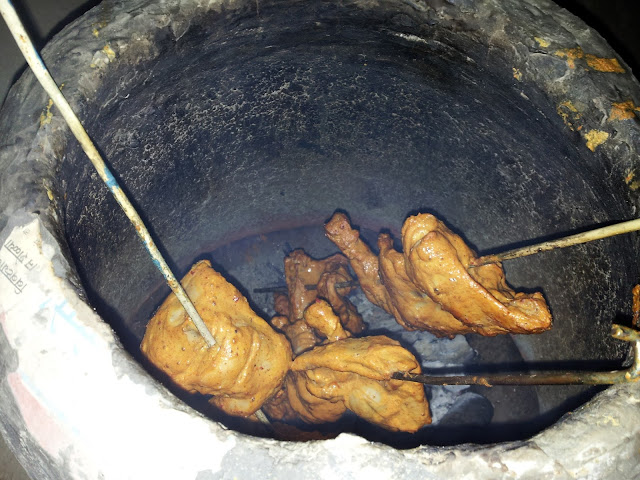 |
| Tandoori Chicken is cooked in a clay oven called the Tandoor. Tandoor is heated by the charcoal or wood which also provide the smoky flavor to it. Marinated chicken skewed on a skewer and cooked in Tandoor. Photo: Wikimedia |
Traditionally, tandoori dishes are cooked in a tandoor, an oval-shaped clay oven with a small fire in the bottom. The heat rises gradually but ultimately reaches a much higher temperature than a barbeque.
A tandoor is normally used to cook naan bread, meats, and kebabs (meat or paneer). The bread is stuck to the sides, the kebabs stood vertically and whole chickens rested on a grid over the fire.
For domestic cooking, a tandoor is not really convenient but the meat dishes can be reproduced on a barbeque or in the oven. The bright red appearance of tandoori meats which you may see in Indian restaurants is produced by a food dye which really isn’t necessary to enhance the look of your tandoori dishes.
I have a great fondness for tandoori style food. It has flavor, without being "hot" or high in calories or too filling. In fact, it's an ideal dish summer or winter, if you fancy something a little different. As a bonus, it doesn't take hours to prepare. Of course, you can take all the effort out of it and use a pre-prepared mix, but I think they have less flavor and you can’t use them for anything else, whereas if you use the individual spices, you can make other dishes as well.
You can easily make tandoori chicken (whole), tandoori lamb chops (pork would be more unusual, but there’s no reason why you shouldn’t use it, if you prefer) and lamb tikka (kebabs) but my personal favourite is chicken tikka because it’s so quick so here’s my own recipe.
This recipe serves two people - multiply it for as many people as you want.
Ingredients
2 Chicken breasts
1 small tub Greek yogurt
1 tsp ground cumin
1 tsp ground coriander
½ tsp ground turmeric
½ tsp ginger powder
½ tsp chili powder (or to taste)
1 small clove garlic, crushed
salt to taste
1 tbsp lemon juice
Cut the chicken breasts into 1-inch cubes and set aside.
Mix the spice powders and garlic into the yogurt. You can use low-fat yogurt if you prefer. You can also use fresh ginger or ginger paste from a jar rather than ginger powder but go easy on the quantity as it can be quite over-powering.
At this point, you can also mix in the salt and lemon juice but if you do so, don’t leave the chicken to marinade for more than about 20 minutes or it will become very dry when cooked. If you want to marinade it for a longer time, add the salt and lemon juice just before you cook the dish or sprinkle on to serve.
Thread the chicken onto skewers and either barbeque or cook on a grill using medium heat until the chicken is slightly browned and cooked through.
For a light meal, serve with salad, pitta or naan bread and lemon wedges or for something more substantial with rice and dahl.


